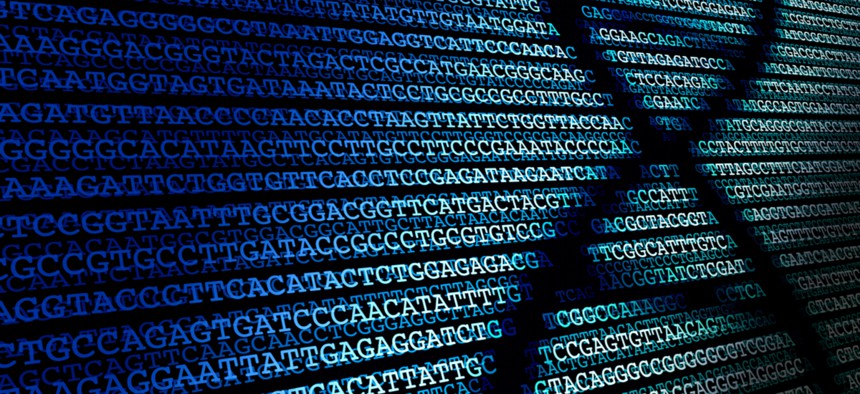The Genomic Revolution Reaches the City Crime Lab

enzozo/Shutterstock.com
How will law enforcement handle the deluge of new information available from DNA?
Lisa Ziegert disappeared from the gift shop where she worked on April 15, 1992, and her body was found four days later. From then until this past Monday, her murder remained unsolved.
Then on Monday, the local district attorney’s office in Massachusetts announced the arrest of a 48-year-old man for Ziegert’s death. Among the clues that led police to him was a computer-generated “mug shot” based on DNA found at the crime scene 25 years ago. Back then, the idea of predicting a face based on DNA would have seemed like science fiction. It is still rare today, but law-enforcement officials can quite easily order up such a test from the Virginia-based company Parabon NanoLabs.
Ziegert’s case is already being touted as an example of the power of new DNA technologies to solve crimes. In many ways, it’s the perfect example to take to the media: a young female victim, an infamous murder, a 25-year-old case. It’s unclear exactly how pivotal the DNA evidence was—the district attorney said “a number of factors” contributed to narrowing down the suspects—but there will almost certainly be more cases like this involving DNA.
With the cost of sequencing rapidly falling, forensics labs have been looking for new ways to generate leads out of DNA. “The idea of looking at markers of ancestry, eye color, and hair color has been attractive for years,” says Peter Vallone, who leads the applied-genetics group at the National Institute of Standards and Technology. New ways of interpreting DNA, however, are also more reliant on algorithms that are often secret.
Forensics labs currently use a DNA-analysis technique that is decades old and limited in scope. Instead of sequencing whole genes as cutting-edge academic research labs often do, forensics labs look for something called short tandem repeats (STR). These are repeated snippets of DNA that show up in parts of the genome that do not code for genes. Forensic labs do not actually know the sequence of the STRs they test, but they can count the number of repeats at several specific locations in the genome. Count enough repeats in enough places, and the pattern is fairly unique to each person. The FBI’s Combined DNA Index System, or CODIS—the database that police run DNA samples against—currently uses 20 core STRs to make matches.
“The forensics community,” says Cydne Holt, is “very conservative, and rightly so.” Holt is the chief scientific officer of Verogen, a forensic-genomics company recently spun out of Illumina, the major U.S. manufacturer of DNA-sequencing machines. Illumina has been on a bit of spree lately, forming new ventures to expand uses of DNA sequencers—first liquid biopsies, at-home genetic tests, and now forensics.
With DNA sequencers, forensics labs could actually read the sequences of the STRs, which could help match or rule out samples in tricky cases with degraded DNA or samples mixed with DNA of multiple people. Verogen already offers a forensics kit that works with Illumina’s DNA-sequencing machines to analyze ancestry, hair color, and eye color information along with STRs. DNA sequencers are not yet used in forensics labs, though a handful of labs are currently validating them for potential future use. The California Department of Justice, for example, began validating DNA-sequencing tools about two years ago and plans to complete the process within the next year.
In general, however, there is little regulatory oversight over how law enforcement can use these new DNA tests. DNA left at a crime scene is considered abandoned material, and police can do pretty much anything they like with it and the information encoded in it. “The law still treats an abandoned single cell of genetic material the way it treats a mask abandoned by a robber,” says Erin Murphy, a professor at New York University’s law school and the author of Inside the Cell: The Dark Side of Forensic DNA. Individual crime labs validate the tests they use, but there is no agency to make sure interpretations are correct.
As DNA-analysis techniques become more sophisticated, they will also become more reliant on proprietary algorithms to interpret the DNA. The secrecy can make it hard to identify problems.
Recently, algorithms used to look at STRs have come under fire after being examined by expert witnesses. ProPublica and the The New York Times reported in September that New York City’s DNA lab stopped using two methods for analyzing degraded and mixed DNA samples after their accuracy came under question. By then, the methods had already been used in thousands of criminal cases.
Law enforcement can also use commercially available software like TrueAllele and STRmix for mixed DNA samples. The Electronic Frontier Foundation has urged courts to allow defendants to review the source code for TrueAllele. Parabon NanoLabs, which does the facial reconstruction from DNA, has not shared its algorithms either, and it has been criticized by researchers for overstating the science.
Twenty-five years ago, when Lisa Ziegert was killed, DNA evidence was just beginning to enter the criminal-justice system. It is now routine, and its uses are only expanding. There will be new ways of using DNA to solve crimes, but there may be new ways of misusing DNA, too.





